By Scott Housden -
Conditioning for goalkeepers is key throughout the season, and not just during pre-season. Specificity is also a key element for goalkeeper fitness. This is achievable by utilising specific traits that a goalkeeper undertakes during a game such as, short sprints, diving and recovering from dives.
The drill below is superb for allowing the goalkeeper to improve their fitness within their goalkeeping environment. It has been around for many years and is a drill that I undertook during my playing days and is one that my goalkeepers undertake three times throughout the year; in pre-season, halfway through the season and towards the end of the season.
Set-Up
The diagrams and descriptions below illustrate the drill for elite and semi-professional level goalkeepers. However, the number of cones can be reduced to 4 or even 3 for junior goalkeepers (therefore reducing the number of saves being made. The drill is best suited for 2 – 6 goalkeepers (again depending on fitness levels). Remember that all serves are thrown and not kicked throughout this drill
Equipment required: 5 large cones, 2 small cones, 6 footballs.
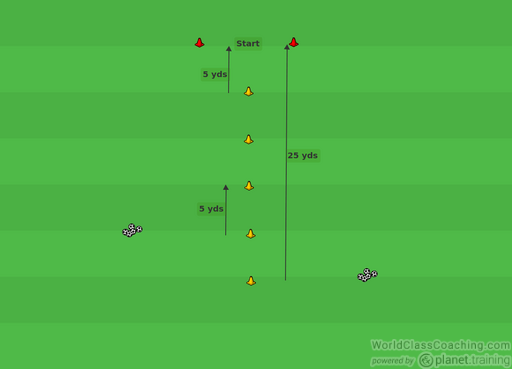
The goalkeeper runs up to first cone and touches the cone and take 2 quick small lateral steps to the left and sets for a thrown delivery from the server for a simple save, the goalkeeper then returns the ball to the server, touches the same cone and then moves quickly to the next cone and repeats at all 5 cones (all on the left hand side). The goalkeeper then sprints back to start line when finished.
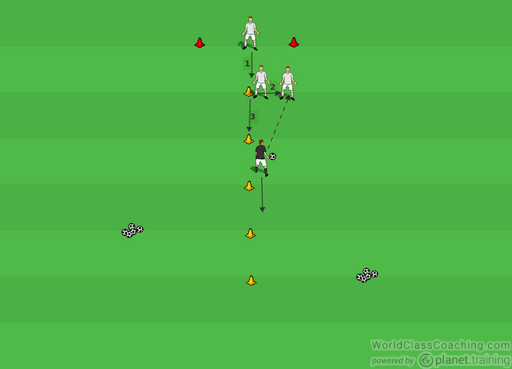
Repeat on right hand side. Sprint back to start line when finished.
Repeat on both sides, starting on the left at the first cone, then moving behind the cone and touching the cone repeat on the right hand side before moving to the next cone and repeating (at all 5 cones). Sprint back to start line when finished.
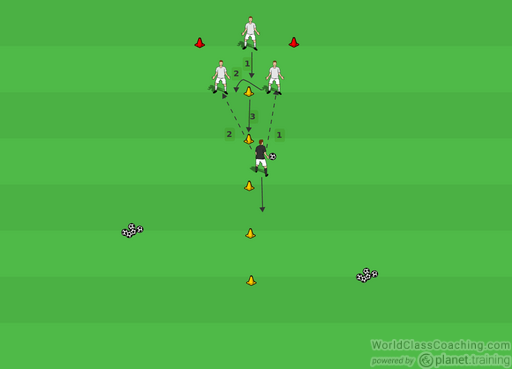
Run quickly to the first cone and touch and set for server to throw the ball to the left hand side of the goalkeeper at waist height for foot knee shoulder diving save to the goalkeeper’s left hand side. The goalkeeper returns the ball to server whilst on the ground, then gets up touches cone then moves to next cone to repeat (to all 5 cones). Sprint back to start line when finished.
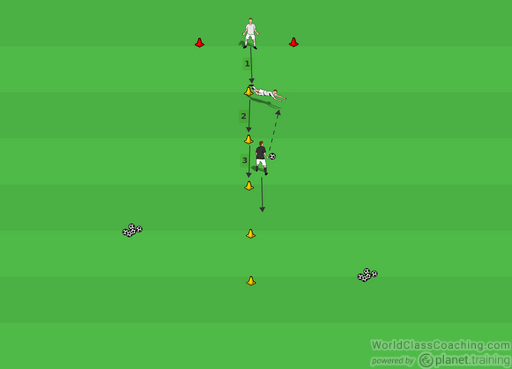
Repeat on the right hand side. Sprint back to the start line when finished.
Repeat on both sides, starting on the left at the first cone, then moving behind cone and touching the cone repeat on the right hand side before moving to next cone and repeating (at all 5 cones). Sprint back to start line when finished.
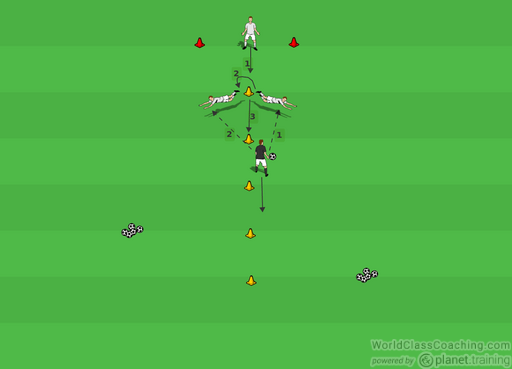
Sprint to the first cone and move around the cone from left to right (clockwise) and set behind the cone for server to throw the ball to the left hand side of the goalkeeper at waist height for foot knee shoulder diving save to the goalkeeper’s left hand side. The goalkeeper returns the ball to the server whilst on the ground, then gets up touches cone then moves to next cone to repeat (at all 5 cones). Sprint back to start line when finished.
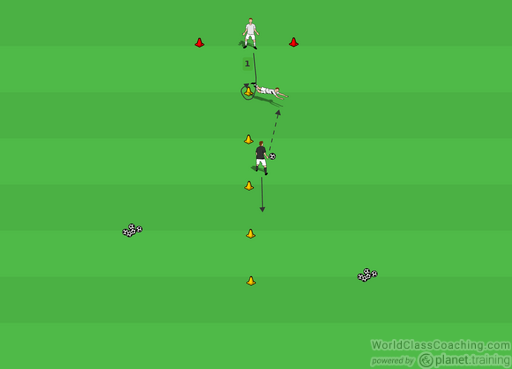
Repeat on the right hand side, moving around the cone from right to left (anti-clockwise). Sprint back to start line when finished.
The goalkeeper moves laterally on the right hand side to the first cone and sets in front of each cone with the server to throw the ball to the left hand side of the goalkeeper at waist height for a foot knee shoulder diving save to the goalkeeper’s left hand side. The goalkeeper returns the ball to server whilst on the ground, then gets up and moves laterally to ‘set’ in front of the next cone to repeat. Once the goalkeeper has completed the 5th cone they then move to the other side of the cones to repeat on the other side with the server serving the same thrown delivery. Short sprint to the start line when finished.
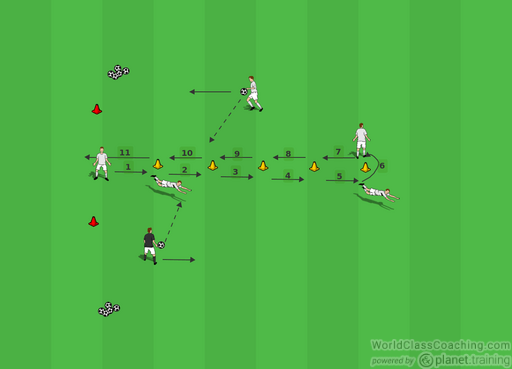
This is repeated starting from the other side of the row of cones. Short sprint back to start line when finished.
Both numbers 9 and 10 (above) are then repeated without a rest in between the sequences, i.e. when sequence 9 has been completed the goalkeeper sprints to the start line to commence sequence 10.
Sprint to the first cone and touch and set for server to throw the ball to the left hand side of the goalkeeper at waist height for foot knee shoulder diving save to the goalkeeper’s left hand side. The goalkeeper returns the ball to the server whilst on the ground, then gets up touches cone then moves to cone 2 to repeat foot knee shoulder diving save (returning the ball to the server). The goalkeeper then moves back to cone 1 and repeats, then to cone 3 and repeats, then back to cone 1 and repeats, then to cone 4 and repeats, then back to cone 1 and repeats, then to cone 5 and repeats then finally back to cone 1 and repeats the dive. Short sprint back to start line when finished.
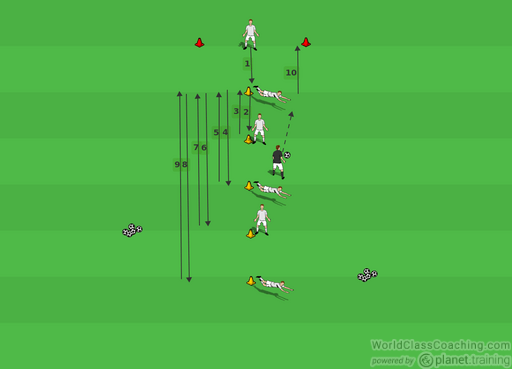
Sequence 12 is repeated albeit with the server throwing the serve to the goalkeeper’s right hand side.
Both numbers 12 and 13 are then repeated without a rest in between the sequences, i.e. when sequence 12 has been completed the goalkeeper sprints to the start line to commence sequence 13.
Coaching Points
As we are working on specific goalkeeper conditioning we must ensure that all actions involved in undertaking this drill albeit simple are done to the best of the goalkeeper’s ability, especially when they are fatiguing.
- Quick balanced movement to each cone, with a balanced ‘set’ position ready to make a save.
- Attacking the ball and leading with your hands when making a foot knee shoulder diving save.
- Quick recovery after making a diving save using your top ‘pendulum’ leg and forward moving top shoulder motion.
- Try to encourage consistency throughout the drill (quick balanced movement, ‘set’ position and diving technique).
By Scott Housden
Scott is both a UEFA ‘B’ and UEFA ‘B’ Goalkeeping Coach and holds a Masters in Sports Management. He has been a goalkeeper coach in professional football in the UK and Australia at First Team, Academy and Women’s levels. He currently runs a Goalkeeper Academy in the Western Suburbs of Brisbane, Australia.


